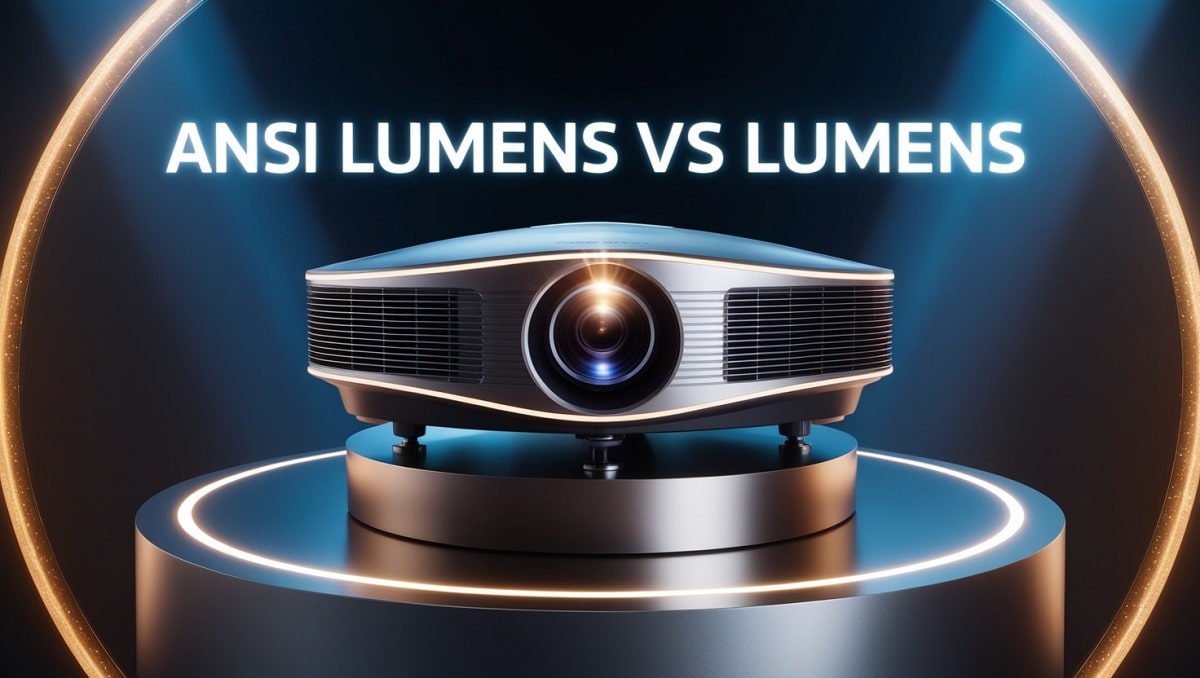Last Updated on July 17, 2024 by Admin
Page Contents
Introduction to ANSI Lumens vs Lumens:
The debate of ANSI Lumens vs Lumens often comes up when choosing the best projector for home theaters. Brightness is the most critical factor when choosing a projector. There are several metrics to measure brightness, but for projectors, it is typically measured in Lumens or ANSI Lumens.
In some projector specifications, you will find Lumens, while in others, you will see ANSI Lumens. Selecting a projector based on Lumens and ANSI Lumens can make a significant difference. Therefore, it is essential to understand the difference between ANSI Lumens Vs Lumens when choosing a projector.
What are Lumens?
We have already explained What are Lumens in one of our previous articles. However, here is a brief summary:
In general, Lumens is a unit that measures the brightness emitted from a light source. It is a universal method for calculating the brightness of various light sources, such as bulbs, flashlights, and projectors. In the case of projectors, Lumens measures the brightness of the projector bulb. The higher the brightness, the better the projected image will appear.
What are ANSI Lumens?
ANSI Lumens is established as the standard testing method for measuring brightness by the American National Standards Institute (ANSI). This method is specifically designed for projectors to ensure a consistent and reliable measurement of brightness for consumers.
ANSI Lumens also measures the brightness of the light source, but the method of measurement it uses is what makes it more reliable and standardized than Lumens. We will discuss the measuring method in the next section.
Key Differences Between Lumens Vs ANSI Lumens
Measuring Methods:
- Lumens: Lumens are measured by placing a light-measuring device at the center of the screen or surface to measure brightness. Typically, projectors emit more brightness at the center.
- ANSI Lumens: ANSI Lumens measures projector brightness across the entire surface area, enhancing reliability. Initially, the projector is placed at a specific distance from the surface in a dark room. The projected image is then divided into nine equal sections (3×3 grid). Brightness is measured in each of these sections, and an average value is derived (by adding the values of all nine sections and dividing by 9), representing the ANSI Lumens value.

Factors such as distance, screen type, and other testing conditions are standardized ANSI standards. This ensures uniformity across manufacturers in measuring projector brightness, enabling customers to make fair and accurate comparisons between different models.
Measurement Standards:
- Lumens: Lumens act as a universal unit for measuring the brightness or light output of various light sources.
- ANSI Lumens: ANSI Lumens is specifically designed for measuring the accurate brightness of a Projector.
Accuracy and Consistency:
- Lumens: The Lumens value for the same product (projector) can vary depending on its testing method.
- ANSI Lumens: On the other hand, ANSI Lumens provides greater accuracy and consistency because companies must adhere to strict testing procedures mandated by ANSI.
Relevance to Projectors:
- Lumens: Choosing a projector based solely on Lumens may result in unsatisfactory output.
- ANSI Lumens: ANSI Lumens measures brightness across every corner of the screen, providing a more reliable metric for consumers.
Real-World Examples on ANSI Vs Lumens:
Understanding ANSI Lumens vs Lumens helps in choosing a projector that performs effectively across different lighting environments.
For instance, a projector rated at 1500 ANSI Lumens might appear brighter than one rated at 2000 Lumens in a room with ambient light.
ANSI Lumens considers standardized testing conditions, such as room brightness and screen size, offering a more accurate representation of real-world performance.

Technical Insights:
Lumens can be measured simply by placing a light-measuring device in the middle of the surface. In contrast, ANSI Lumens are measured under controlled conditions defined by ANSI. This includes using standardized screens, specific distances and calibrated light meters. These strict testing procedures ensure that ANSI Lumens ratings are comparable across various projector models and brands.
Expert Opinions:
Projector enthusiasts often discuss the importance of ANSI Lumens vs Lumens for achieving optimal image quality. According to projector industry experts, ANSI Lumens are more important than Lumens when selecting a Projector.
John Doe from Projector Experts Inc. quotes: “ANSI Lumens provide consumers with a precise indication of projector brightness across various settings. This standardized measurement helps prevent confusion and ensures satisfaction with the projector’s performance.”
Even in our projector reviews, our experts consistently recommend prioritizing ANSI Lumens over Lumens for informed decision-making.
Case Studies: Projector A vs Projector B
To examine practical differences, we compared two projectors: one rated at 2000 Lumens and the other at 2000 ANSI Lumens. In a dimly lit room, the projector with 2000 ANSI Lumens delivered a clearer and more vibrant image compared to the 2000 Lumens projector. This difference is due to ANSI Lumens’ use of standardized testing conditions, which ensure more accurate measurement and evaluation of brightness.
Additional Tips for Choosing a Projector
As we mentioned, brightness is a crucial and essential factor to consider when buying a projector. However, it’s not the only factor you should focus on. Other important factors include resolution, throw distance, contrast ratio, the technology used, and the overall cost of the projector when making your final decision.

How to Convert ANSI Lumens to Lumens?
Many consumers are often confused by the ANSI Lumens vs Lumens ratings in projector specifications. Hence, they assume ANSI Lumens and Lumens are different measuring units like meter-inch or kgs-pound. This confusion leads to questions about how to convert Lumens to ANSI Lumens.
However, it’s important to note that both Lumens and ANSI Lumens are actually the same measuring unit—the difference lies in how they are measured. While Lumens measures the brightness projected at the center of the surface, ANSI Lumens calculates the average brightness distributed across different sections of the screen.
Conclusion:
Understanding the distinctions between Lumens Vs ANSI Lumens empowers consumers to make smarter choices when selecting projectors.
ANSI Lumens offers a standardized, reliable measure of brightness specifically tailored for projector applications. When investing in a projector, prioritizing ANSI Lumens ensures you get the brightness level suited to your viewing environment.
For accurate projector brightness, it’s essential to know the significance of ANSI Lumens vs Lumens. Explore more articles on our blog for further insights into projector technology, tips, and reviews.
We value your feedback, so feel free to leave comments or questions below to continue the discussion!
Don’t forget to share this article with others who might find it helpful! Sharing valuable information like the differences between ANSI Lumens and Lumens helps others make informed decisions when choosing projectors.

